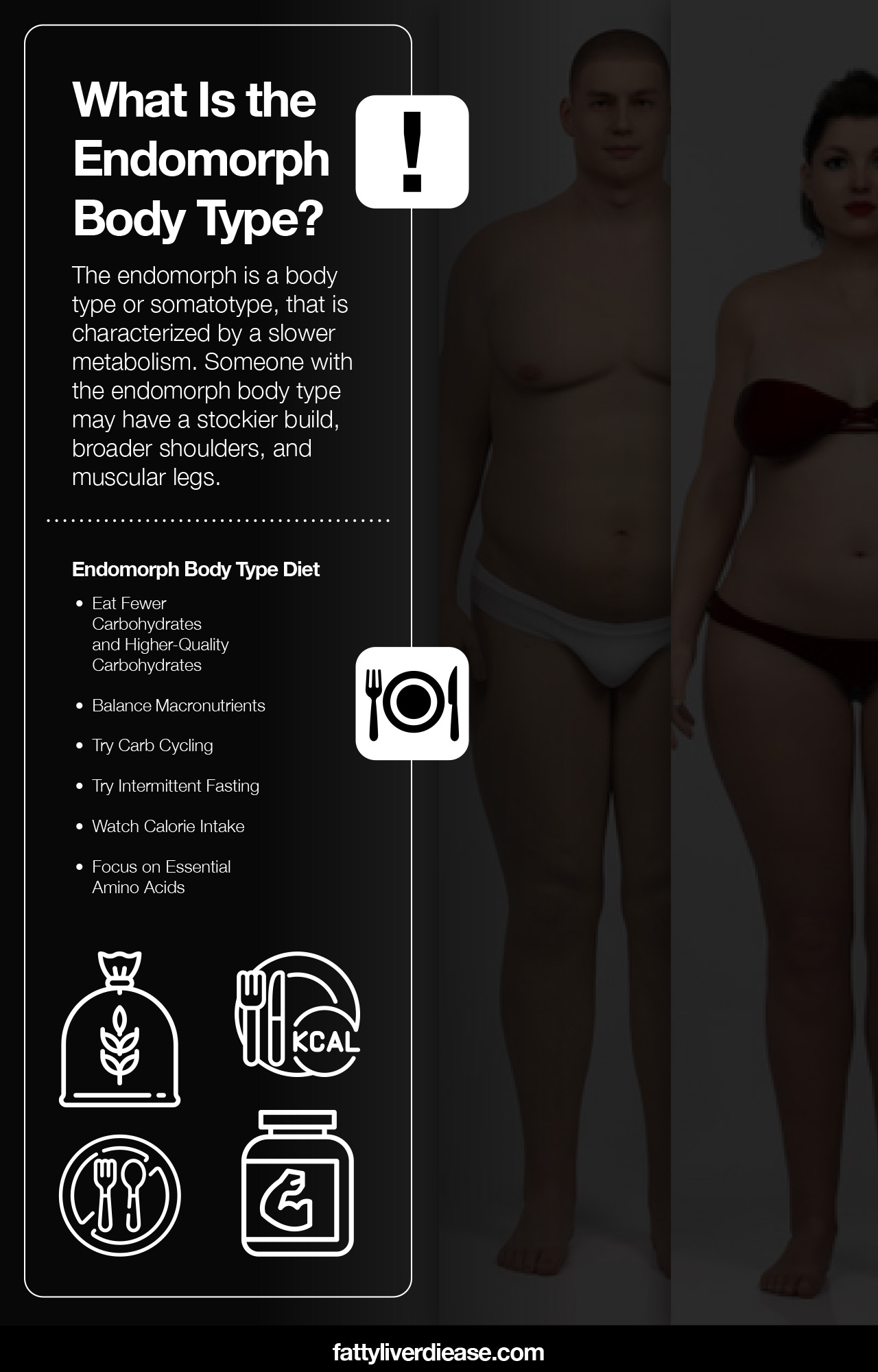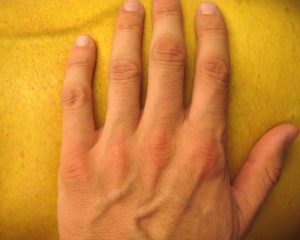Body type diets have been gaining popularity as a tactic for losing weight and supporting health. Body types tend to be split into three categories: ectomorphic, endomorphic, and mesomorphic. In this article, we focus on what it means to have an endomorphic body type and how to follow an endomorph diet.
What Is the Endomorph Body Type?
The endomorph body type is one of the three body types devised by psychologist William Sheldon. The other two designated body types are ectomorphs and mesomorphs. It’s important to recognize that these categorizations are fluid and individuals can reflect characteristics of two or more body types. The body typing strategy provides guidelines for analyzing and observing trends and patterns in your own diet and lifestyle.
The endomorph lies on the opposite end of the spectrum from the ectomorph diet. Endomorph is a body type, or somatotype, that is characterized by a slower metabolism. Someone with the endomorph body type may have a stockier build, broader shoulders, and muscular legs.
While endomorphs put on muscle mass easily, they also tend to put on fat easily as well. Many endomorphs tend to hold onto fat around the abdominal area, which can increase systemic inflammation and stress hormones like cortisol. Endomorphic body types may be genetically predisposed to developing metabolic disorders like insulin resistance, diabetes, hormonal imbalances, and fatty liver disease.
This does not mean that an endomorphic body type can’t be lean and slender. It simply requires a few adjustments to boost the metabolism and support muscle growth while burning fat.
How can you tell if you tend towards an endomorphic body type? If you have an endomorphic body type, you may notice a few of the following characteristics:
- You gain weight easily
- You gain muscle easily
- It’s difficult to lose weight
- You tend to store fat in the lower half of your body

Endomorph Body Type Diet
Following certain metabolic guidelines for the endomorphic body type will help you support your health, increase your muscle mass. If you’re struggling with metabolic disorders such as insulin resistance, type 2 diabetes, obesity, or fatty liver disease, these dietary guidelines will be useful too.
1. Eat Fewer Carbohydrates and Higher-Quality Carbohydrates
Generally, the endomorphic body type thrives on fewer carbs. However, this doesn’t mean take out carbs altogether. Instead, simply balance your carbs. It’s also important to choose high-quality carbs that come from whole foods like quinoa, brown rice, oats, fruits, sweet potatoes, bets, and other veggies.
Because endomorphs tend to be innately more sensitive to carbohydrates, they are more prone to developing metabolic disorders. As a result, it’s particularly important for individuals with an endomorphic body type to stay away from refined carbohydrates and added sugars. These carbs are broken down quickly, released into the bloodstream, and spike the blood sugar, leading to insulin resistance and weight gain. Stay away from baked goods, cookies, crackers, ice cream, white bread, white rice, and white pasta.
On the other hand, complex carbohydrates and broken down more slowly, provide sustained energy, and are bundled with health-boosting dietary fiber, vitamins, minerals, and antioxidants.
2. Balance Macronutrients
The endomorph diet plan should include a careful balance of all macronutrients. Some may suggest that endomorphs follow a diet that restricts carbohydrates. However, it’s likely more beneficial if endomorphs strive to eat balanced portions of all macronutrients, meaning that carbs, proteins, and fats each provide about one-third of daily calories.
As discussed above, carbs should come primarily from whole foods like fruits, veggies, and whole grains.
Proteins should afford all essential amino acids, which are the raw materials that make up protein. We require optimal ratios of essential amino acids in our diets in order to support muscle synthesis, enzyme production, and metabolic health. Endomorphs should aim for high-quality protein sources. While lean meats like chicken and turkey, low-fat dairy products, and eggs provide all essential amino acids, endomorphs may benefit from following a plant-based diet. Plant-based diets improve metabolic function, lower inflammation, fight fatty liver disease, and help increase insulin sensitivity.
This doesn’t mean they should go entirely vegan; instead, endomorphs should aim to get most of their calories from plant-based foods each day. To get optimal ratios of essential amino acids from plant foods, it’s important to combine nuts, seeds, beans, and whole grains throughout the day.
Similarly, with the exception of fatty fish, endomorphs should get most of their dietary fats from plant-based sources. Endomorphs may be genetically sensitive to saturated fats found in meat and dairy and the trans fats found in processed foods. Saturated and trans fats raise cholesterol levels, raise triglycerides, worsen insulin resistance, and contribute to cardiovascular disease.
The plant-based Mediterranean or adjusted paleo diet to focus on more plant-based foods may be a good guideline for endomorphs looking to maximize their metabolic health, gain muscle, and lose weight.
3. Try Carb Cycling
Because endomorphs tend to be sensitive to carbohydrates, they may respond very positively to carb cycling. Carb cycling means altering your intake of carbs between higher carb and lower carb days. This allows the endomorphic body to glean the benefits of a low-carb diet, without depriving the body of carbs. Higher carb days should be reserved for days when you work out and expend extra energy.
4. Try Intermittent Fasting
Endomorphs may be particularly responsive to intermittent fasting. To incorporate intermittent fasting into your routine, simply choose a could nonconsecutive days per week to incorporate a fasting period. This might mean that on Monday’s and Friday’s, you avoid eating after a six o’clock dinner until ten o’clock the following morning. This would mean that you incorporate two 16-hour fasting periods into your week.
Fasting has immense health benefits for the endomorphic body type. Fasting boosts the body’s fat-burning capacity while also resetting the metabolism, lowering systemic inflammation, and clearing cellular waste associated with oxidative stress.
5. Watch Calorie Intake
Because endomorphs tend to have a naturally slower metabolism, it’s important to be aware of calorie intake to prevent weight gain. If you’re striving for weight loss, you must create a calorie deficit. This means that the calories you burn outweigh the calories you consume. This will allow your body to burn stored fat for energy.
Be cautious not to be overly restrictive with your caloric intake. Following a sustained very-low-calorie diet can be dangerous for your health, precipitate unhealthy rapid weight loss, and lead to muscle wasting. Moreover, your body needs sufficient calories to build muscle, which increases your resting metabolic weight and leads to more fat burning.
Counting macros is a helpful strategy for counting calories. Though less reliable, intuitive eating can also help you control portion sizes. To engage in intuitive eating as effectively as possible, avoid mindlessly eating in front of the television or computer. Chew each bite slowly and deliberately, enjoying the taste and texture. Eating slowly allows you to more readily sense when your body is full to respond to these ques.
6. Focus on Essential Amino Acids
Muscle building is critical in promoting optimal health for the endomorphic body type, while also burning excess fat. Since endomorphic body types tend to thrive on limited animal products, the essential amino acid balance must be obtained through carefully-planned plant-based proteins that you eat throughout the day. Most plant proteins, except for soy products, have at least one limiting amino acid. Unfortunately, even if the body has all other essential amino acids, it can’t fulfill its daily functions if the final amino acid is not present in proper proportions. In particular, the body builds muscle incompletely and inefficiently if essential amino acids are missing. A high-quality essential amino acids supplement can provide easily digested individual essential amino acids, fueling muscle synthesis without the added calories of meat protein or whey protein.
Endomorphic Diet Plan Sample
This diet plan for endomorphs will go through all the daily meals, providing options for normal carb intake, and low-carb day. The key is not to view eating as “dieting,” but rather as a sustainable lifestyle shift to fuel your body and support your health.
- Breakfast: When evenly splitting calories across all macronutrients, an excellent breakfast might include two scrambled egg whites, one scrambled egg yolk, strawberries, and two slices of whole-grain toast topped with half an avocado. To adjust this breakfast to a low-carb day, simply remove the whole-grain toast and add an egg white or a few more slices of avocado.
- Lunch: Create a chopped kale salad and layer with a scoop of brown rice, grilled tofu, walnuts, and chopped tomatoes. Drizzle with an olive oil vinaigrette. For a low-carb option, remove the brown rice and add a little more tofu.
- Dinner: For dinner, try preparing grilled salmon, quinoa, and roasted asparagus. On low-carb days, remove the quinoa and increase the volume of non-starchy vegetables. Try roasting a vegetable medley of asparagus, squash, broccoli, cauliflower, and onions.
- Snack: For a balanced snack, spread a tablespoon of peanut butter on rice thins. For a low-carb snack, spread a tablespoon of peanut butter on celery sticks.
Just as a reminder, if you’re limiting your intake of animal-based protein, it’s important to ensure that you get optimal ratios of essential amino acids. An essential amino acid supplement is an excellent way to remove the inconvenience of having to plan out plant-based protein sources. If you enjoy a morning beverage like coffee or tea, consider adding a high-quality amino acid supplement to make sure you’re promoting healthy metabolism and muscle growth.

Endomorphic Exercise Regimen
The endomorph’s nutrition plan should be paired with a workout plan with a to maximize health benefits and fitness results.
The Importance of High-Intensity Interval Training
Endomorphic body types tend to respond extremely well to high-intensity interval training, better known as HIIT. This kind of training falls under the umbrella of metabolic training, which focuses on intense exertion to boost metabolic rate and optimize metabolic health.
HIIT is characterized by intense exercises followed by a small break. During the exercises, it’s important to give 100% effort to maximize intensity. HIIT, though traditionally focused on cardio, can also incorporate strength-training. For endomorphs, engaging in cardio HIIT, strength-training HIIT, and blended cardio and strength-training HIIT will maximize results.
Check out these examples of high-intensity exercises that you can incorporate into your HIIT workouts.
- Burpees: Burpees are an easy way to get your heart rate up and don’t require any fancy fitness equipment. To complete a burpee, lie on your stomach on the ground. As fast as possible, get to a standing position and jump before returning to the lying position. To add an extra challenge, complete a push-up every time you’re in the lying position on the ground.
- Sprints: Classic sprints are an excellent way to get your heart rate up while burning calories. When starting out, aim to sprint for 10 seconds followed by 5 seconds of rest. Repeat several times until you’re too tired to continue. As your body gets stronger, gradually increase sprinting time.
- Weighted sled: The weighted sled is a piece of equipment available in the gym. This exercise tests both your muscles and cardiovascular endurance. Add just enough weight to the sled so that it’s very challenging to push, but not impossible. While pushing the sled, run as quickly as possible across the gym. Then using a rope, try to pull the sled across the floor to the other side.
- Mountain climbers: Like burpees and sprints, mountain climbers make an easy way to get your heart rate up. Assume a push-up position and bring your knees up, alternating legs as quickly as possible.
- Lunge routine:Lunges can be used to make challenging exercises that test several muscle groups. Holding dumbbells in each hand, complete walking lunges across the room. When you get to the ends of the room, stand in place and complete three standing squats with an overhead press. To complete an overhead press, hold the dumbbells at shoulder height during the squat and when returning to standing position, use your leg muscles to push through your body and raise the dumbbells above your head. Alternatively, complete walking lunges carrying a weighted ball. With each lunge, twist side to side to work your core muscles.
Both increasing lean muscle mass and getting into aerobic shape have significant benefits for the endomorph and work together to maximize health outcomes. While the increase in lean muscle mass improves metabolic function and increases metabolic rate, engaging in aerobic exercise strengthens the heart and cardiovascular system. As a result, this will lower the risk of developing cardiovascular disease.
Avoid Restricting Foods
Let’s eliminate any confusion about the endomorphic diet. Though individuals with an endomorphic body type may be more sensitive to refined carbohydrates, consuming refined carbohydrates is unhealthy for individuals of all body types.
Moreover, just because of potential sensitivity to refined carbs, this does not mean that endomorphs are sensitive to complex carbs. Depriving yourself of complex carbs also means you’d be missing out on essential vitamins, minerals, antioxidants, and dietary fiber.
Things to Keep in Mind
Think you might have an endomorphic body type? A registered dietician or nutritionist can help you determine your body type and provide detailed advice for your specific body type and health conditions.
The Bottom Line
If you choose to follow the endomorphic diet, balanced macronutrients combined with carb cycling or intermittent fasting will help promote optimal metabolic health. High-intensity interval training works with the endomorphic diet to fuel muscle growth and increase fat-burning capacity.























